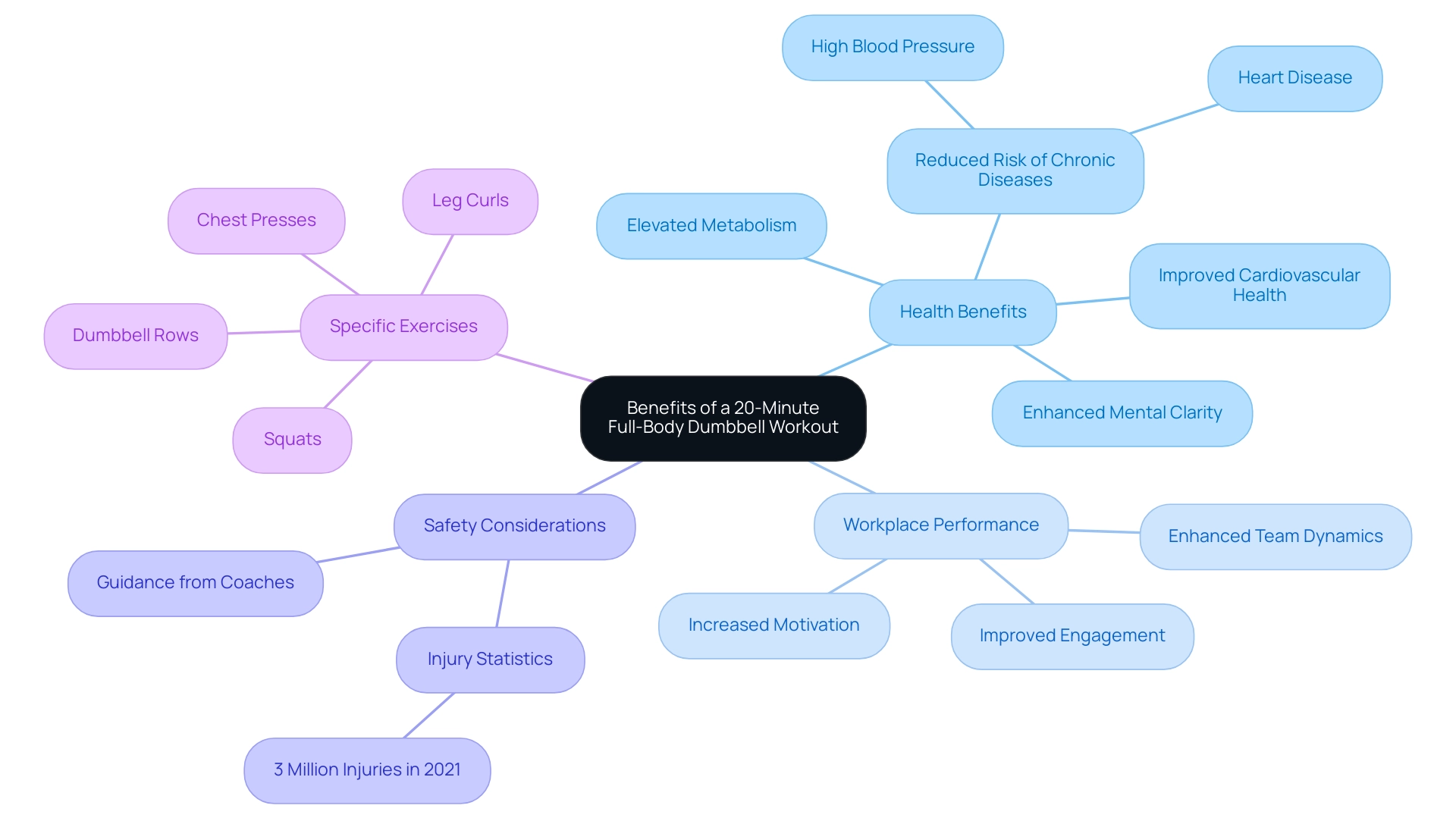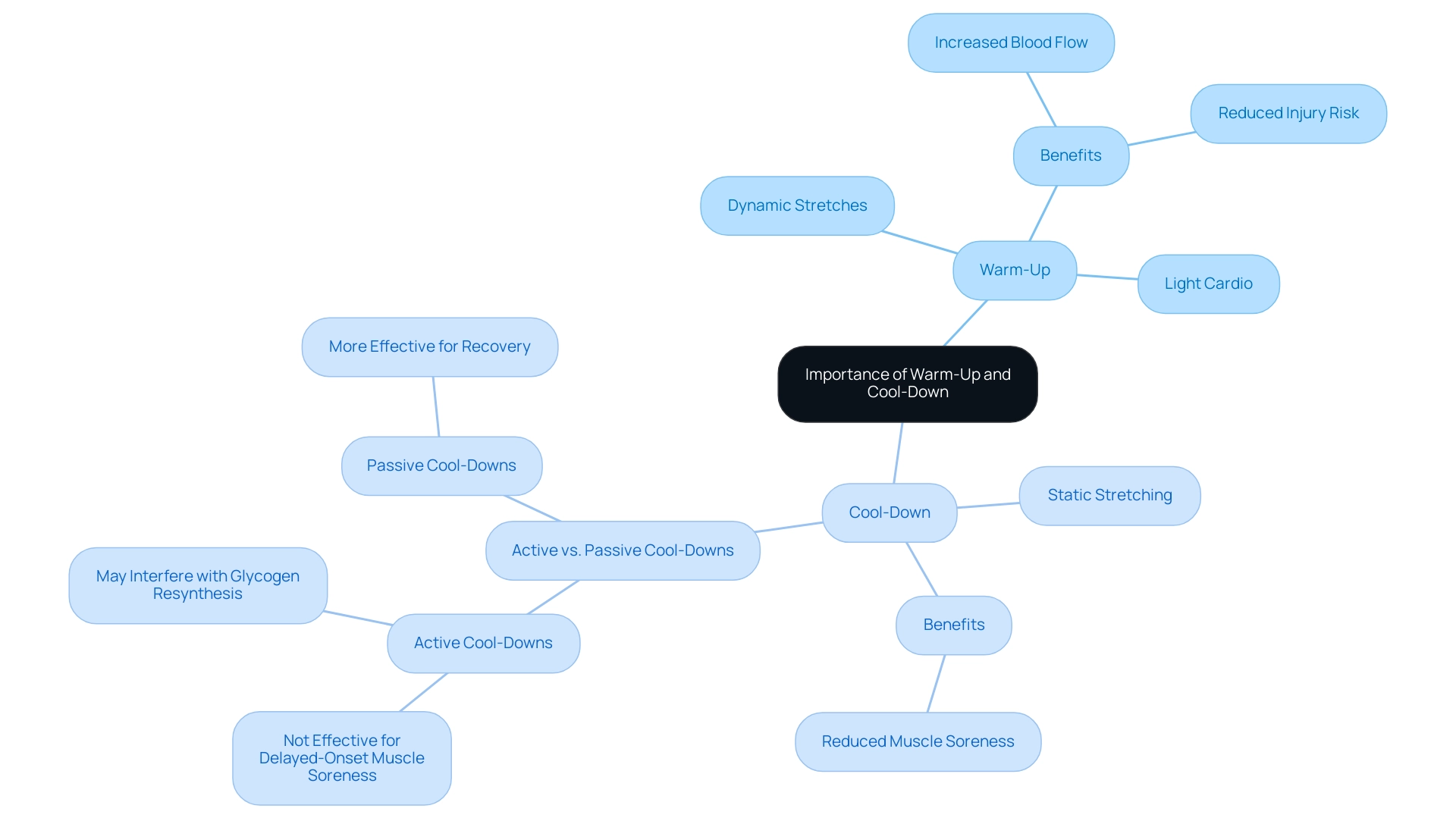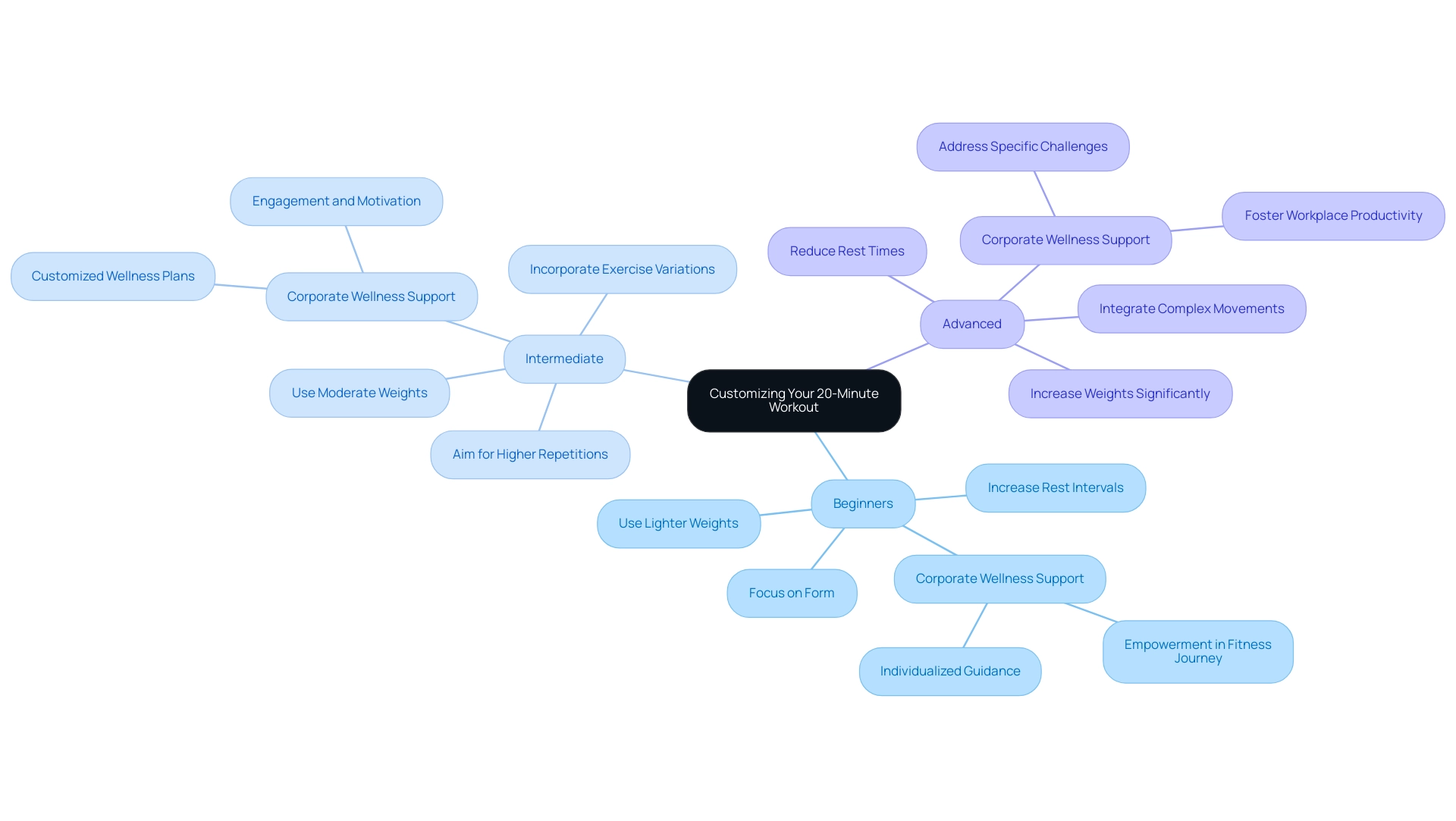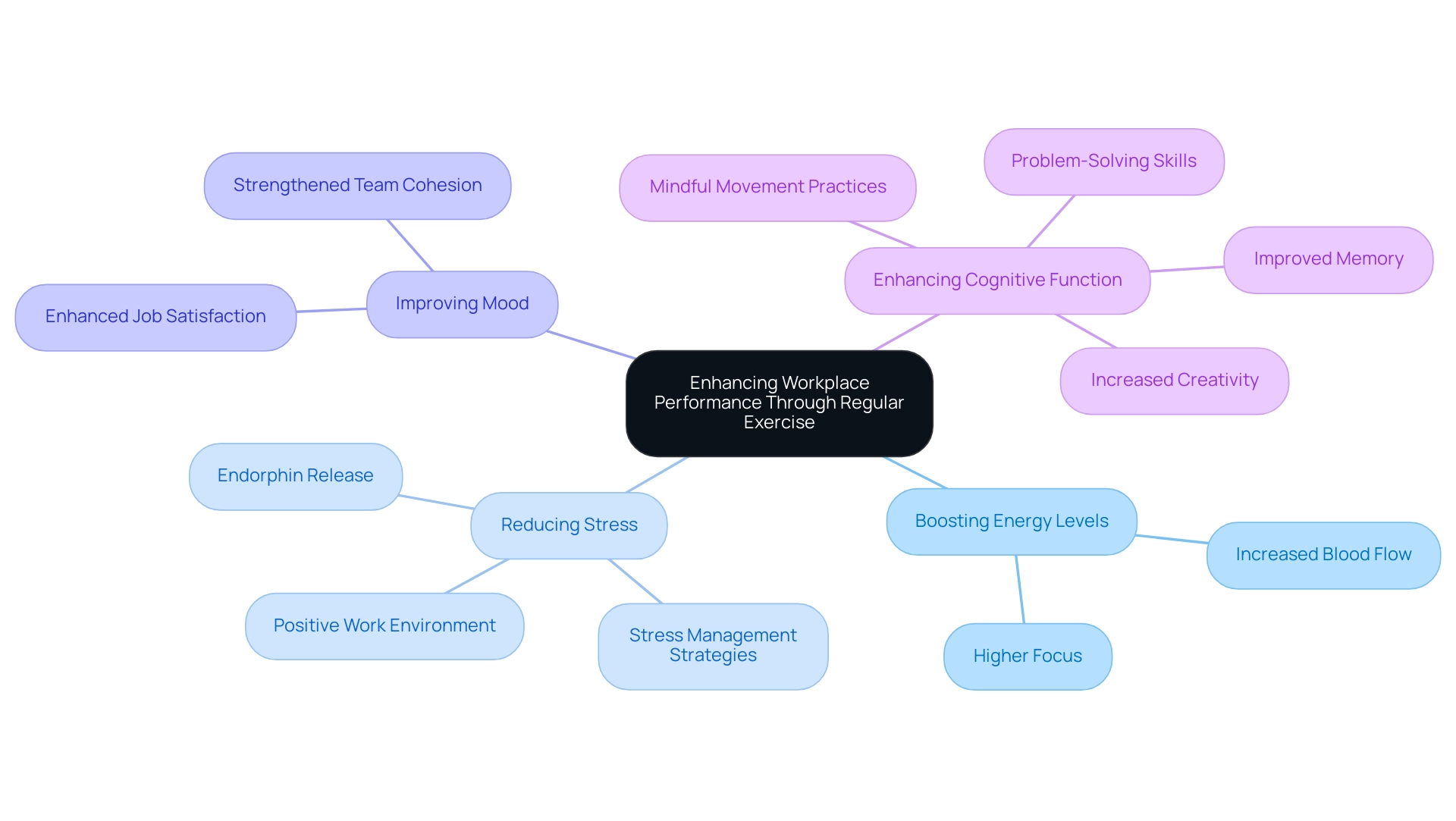Overview
A 20-minute full-body workout with dumbbells serves as an effective exercise routine that significantly enhances overall strength, endurance, and workplace performance, making it an ideal choice for busy professionals. This approach engages multiple muscle groups, improves mental clarity, and can be tailored to various fitness levels. Such customization fosters a culture of wellness that not only boosts productivity but also reduces stress in the workplace. By integrating this routine into corporate wellness programs, organizations can effectively address the challenges faced by HR Benefits Managers, ultimately leading to a healthier, more engaged workforce.
Introduction
In a world where time is often scarce, busy professionals face significant challenges in maintaining health and fitness. A 20-minute full-body dumbbell workout emerges as a powerful solution, offering a multitude of benefits that not only enhance physical strength but also boost workplace performance. This workout format engages various muscle groups, elevates metabolism, and fosters mental clarity—all essential elements for thriving in a demanding work environment.
Furthermore, as organizations increasingly prioritize employee well-being, understanding how to effectively integrate such efficient workouts into daily routines can lead to transformative changes in health and productivity. This article delves into the myriad advantages of a quick yet impactful dumbbell workout, providing insights into:
- Key exercises
- Proper techniques
- The importance of warm-ups and cool-downs
All tailored to accommodate different fitness levels.
The Benefits of a 20-Minute Full-Body Dumbbell Workout
A 20-minute full-body workout with dumbbells presents numerous benefits, particularly for busy professionals striving to maintain their well-being amid demanding schedules. This efficient exercise format engages multiple muscle groups, fostering overall strength and endurance while being easily adaptable to tight time constraints. Research indicates that brief, intense exercise sessions can significantly elevate metabolism, enhance cardiovascular health, and sharpen mental clarity, making them particularly beneficial for workplace performance in 2025.
However, it is crucial to approach exercise safely; in 2021, over 3 million injuries in the U.S. were linked to sports and recreational activities. Regular participation in these workouts, especially when guided by experienced coaches, can lead to heightened energy levels, reduced stress, and improved mood—factors that collectively contribute to a more vibrant and productive work environment. Personalized coaching can assist individuals in making enduring lifestyle adjustments, enabling them to take charge of their wellness and well-being.
Notably, studies have shown that employees who incorporate exercise into their routines report greater motivation and engagement at work. Moreover, the influence of such exercises extends beyond short-term physical advantages; they can also serve an essential function in long-term well-being, decreasing the likelihood of chronic illnesses and encouraging longevity, as emphasized in the case study titled 'Exercise and Longevity.'
Incorporating a 20-minute full-body workout with dumbbells into the weekly routine not only supports individual health but also enhances team dynamics, fostering a culture of wellness that can lead to improved collaboration and productivity. This training routine can consist of movements such as:
- Squats
- Dumbbell rows
- Leg curls
- Chest presses
These can be carried out in a circuit format with brief rest intervals. As Hamelin suggests, using a weight that makes the exercise challenging on the last two to three reps while maintaining proper form is essential for maximizing benefits.
As organizations increasingly acknowledge the significance of employee well-being, these exercise sessions, paired with tailored guidance from Corporate Membership - Contact Our Health Coaches Today, serve as a practical solution for busy professionals aiming to enhance their health and performance. Additionally, strength training can be performed using body weight, resistance bands, or free weights, making it accessible to everyone.

Key Exercises for a Comprehensive Dumbbell Workout
To design an effective 20-minute dumbbell workout tailored for busy professionals, consider incorporating the following key exercises:
- Goblet Squats: Hold a dumbbell close to your chest and squat down, ensuring your back remains straight. This activity effectively targets the legs and core, promoting strength and stability.
- Dumbbell Rows: With a slight forward bend, grasp a dumbbell in each hand and pull the weights towards your hips. This movement engages the back and arms, enhancing upper body strength.
- Dumbbell Bench Press: Lying on a bench or the floor, press the dumbbells from your chest upwards. This activity focuses on the chest and triceps, contributing to upper body development.
- Dumbbell Lunges: Step forward with one leg while holding dumbbells at your sides, alternating legs. Lunges effectively engage the legs and glutes, promoting lower body strength and balance.
- Dumbbell Overhead Press: Stand tall and press the dumbbells overhead, which strengthens the shoulders and arms, crucial for overall upper body fitness.
For optimal results in a 20-minute full body workout with dumbbells, perform each movement for 30 seconds, followed by a 15-second rest. Continue repeating the circuit until you finish the 20-minute full body workout with dumbbells. This organized method not only optimizes training efficiency but also aligns with findings that emphasize the effectiveness of dumbbell routines in enhancing strength and endurance.
Notably, a study found that both 30% and 80% of one-repetition maximum (1 RM) knee extensions elicited similar muscle growth, underscoring the importance of varying intensity in workouts. Consistency is crucial; as Godsey mentions, "if you don't notice changes after approximately eight weeks, you are not training hard enough and need to vary your routine by increasing your weight or sets or the number of activities." Furthermore, the methodological quality of the studies supporting these activities was assessed using the TESTEX scale, ensuring that the conclusions drawn are based on sound evidence.
These activities are particularly relevant for adults aged 18-60 without chronic diseases or injuries, making them ideal for busy professionals aiming to enhance their health and productivity.

Mastering Form: Techniques for Effective Dumbbell Exercises
To effectively master your dumbbell exercises, it is crucial to focus on the following techniques:
- Maintain a Neutral Spine: Keeping your back straight is essential. Avoid rounding your shoulders during activities such as squats and rows to prevent injury and ensure optimal performance.
- Engage Your Core: Activating your core muscles is vital for stabilizing your body, especially when performing a 20-minute full body workout with dumbbells that includes overhead presses and lunges. A strong core supports proper posture and enhances overall strength.
- Control Your Movements: During your 20-minute full body workout with dumbbells, avoid relying on momentum; instead, perform each activity slowly and deliberately. This approach maximizes muscle engagement and reduces the risk of injury, as studies indicate that improper form can lead to significant injury rates in workplace fitness programs.
- Breathe Properly: Proper breathing techniques are essential for maintaining energy and oxygen flow. Inhale during the lowering phase of a workout and exhale during the exertion phase to optimize performance.
- Use Appropriate Weights: Start your 20-minute full body workout with dumbbells using lighter weights to ensure you can maintain proper form. Gradually increase the weight as you become more comfortable and confident in your technique.
Research shows that maintaining proper form not only enhances the effectiveness of strength training but also significantly reduces the risk of injuries. For instance, a study revealed that strength training can decrease nursing home admissions by 84% in older adults recovering from hip fractures, underscoring the importance of safe physical activity practices. Furthermore, participating in strength-promoting activities twice a week can reduce all-cause mortality by 23% and cancer mortality by 31%, emphasizing the wider health advantages of strength training.
Nick Rizzo, Fitness Research Director, emphasizes, "That's why the benefits of resistance training for seniors and older adults are so immense." By mastering these techniques, individuals can enjoy the myriad benefits of strength training, including improved job performance and reduced fatigue, ultimately contributing to a healthier workplace environment. Furthermore, incorporating certain forms of cardio, such as walking with resistance, can also contribute to building strength and muscle, providing a more comprehensive approach to fitness.
Conducting interviews with participants can yield valuable insights into preferences for fitness instruction, allowing for tailored corporate wellness programs that enhance engagement.

The Importance of Warm-Up and Cool-Down in Your Workout Routine
Including a warm-up and cool-down in your exercise regimen is crucial for enhancing performance and avoiding injuries, particularly in a corporate setting where staff may not be accustomed to frequent physical activity.
- Warm-Up: Dedicate 5-10 minutes to dynamic stretches and light cardio activities, such as jogging in place or performing jumping jacks. This initial phase increases blood flow to your muscles, elevating your heart rate and preparing your body for the demands of exercise. Research indicates that a proper warm-up can significantly reduce the risk of injuries. At Foresight Health Coaching, we emphasize the significance of these practices in our customized fitness programs, ensuring that employees are well-prepared for their exercise routines. Notably, recreationally active males showed a trivial performance decrease of −1.9% in CMJ relative peak power at 24 hours post-exercise, underscoring the necessity of adequately preparing the body before engaging in physical activity.
- Cool-Down: After your exercise, allocate another 5-10 minutes for static stretching, concentrating on the muscles you engaged during your session. This practice not only aids in reducing muscle soreness but also enhances flexibility, contributing to overall fitness. Our comprehensive wellness coaching app provides guidance on effective cool-down routines, which can help mitigate discomfort and promote recovery. While the perception of muscle soreness may not always correlate with actual muscle damage, studies have shown that effective cool-down routines can help. However, it is important to note that active cool-downs are not effective for reducing delayed-onset muscle soreness, providing a balanced view on the effectiveness of these routines. Additionally, research on glycogen resynthesis post-exercise indicates that while active cool-downs are theorized to aid in recovery through increased blood flow, they may not significantly enhance glycogen resynthesis compared to passive cool-downs, particularly affecting type I muscle fibers.
Both the warm-up and cool-down phases are vital components of a healthy workout regimen, fostering improved fitness outcomes and supporting a culture of wellness within the workplace. By prioritizing these practices, organizations can enhance staff engagement and productivity, ultimately leading to a more cohesive and resilient team. At Foresight Health Coaching, we believe that empowering individuals with the right tools and knowledge is key to achieving lasting lifestyle changes.
Our corporate memberships encompass in-person wellness discussions and nutrition services, further assisting individuals in their wellness journeys. As noted by Bianca Cattelini, "The authors would like to thank Bianca Cattelini contracted through the Queensland Academy of Sport for her assistance with the infographic," emphasizing the importance of expert insights in developing effective fitness programs.

Customizing Your 20-Minute Workout for All Fitness Levels
To effectively customize your 20-minute dumbbell workout, consider the following guidelines tailored to different fitness levels, while also recognizing the broader context of corporate wellness programs that enhance employee health and productivity:
-
Beginners: Start with lighter weights to prioritize mastering your form. Concentrate on executing each movement accurately, which may involve decreasing the number of repetitions or lengthening rest intervals between activities. This foundational approach is crucial for preventing injuries and building confidence. Tailored corporate wellness programs, such as a 20-minute full body workout with dumbbells offered by Corporate Membership, can support beginners by providing individualized guidance, ensuring they feel valued and empowered in their fitness journey.
-
Intermediate: Progress to moderate weights while aiming for higher repetitions. At this stage, incorporating variations of the exercises can further challenge your muscles and enhance your overall strength. For instance, incorporating a twist into a 20-minute full body workout with dumbbells can engage different muscle groups and improve functional fitness. Personalized attention in wellness programs, including customized wellness plans from Corporate Membership, can help intermediate participants stay engaged and motivated.
-
Advanced: For those with a solid fitness base, significantly increase the weights and reduce rest times to elevate the intensity of your exercise. Integrating complex movements, such as combining a squat with an overhead press, can maximize efficiency and stimulate muscle growth. Advanced participants benefit from tailored programs, including a 20-minute full body workout with dumbbells, that address their specific challenges, fostering a culture of health that enhances overall workplace productivity.
Listening to your body is essential; always modify the exercise according to your comfort and fitness level. Research indicates that a 20-minute full body workout with dumbbells, which takes into account individual capabilities and preferences, leads to better adherence and results. A review of personalized technology-based interventions found that tailored approaches are more effective than generic advice, underscoring the importance of customization in fitness programs.
This aligns with the statistic from MyFitnessPal, which highlights that over 200 million users have been empowered to pursue fitness, showcasing the growing interest in personalized approaches.
As Niketan Sharma, CTO of Nimble AppGenie, observes, "Tailored fitness solutions are essential for maximizing staff engagement and satisfaction." By adopting these strategies, organizations can cultivate a culture of well-being that accommodates diverse employee needs, ultimately enhancing workplace productivity and satisfaction. This link between personalized exercise programs and corporate wellness is essential for HR Benefits Managers aiming to invest in their team's health and performance, contributing to decreased absenteeism and reduced healthcare expenses.

Enhancing Workplace Performance Through Regular Exercise
Regular exercise, such as a 20-minute dumbbell workout, can significantly enhance workplace performance through several key mechanisms, especially when supported by personalized coaching:
- Boosting Energy Levels: Engaging in physical activity increases blood flow and oxygen delivery to the brain, enhancing alertness and focus. Research shows that individuals who integrate consistent physical activity into their routines report higher energy levels and enhanced focus, resulting in improved job performance. The extent of changes in health outcomes is connected to training adherence and compliance, emphasizing the significance of regular physical activity in the workplace. Customized coaching can further inspire individuals to sustain their fitness routines, ensuring they enjoy the complete advantages.
- Reducing Stress: Exercise is known to trigger the release of endorphins, the body's natural stress relievers. This biochemical response not only alleviates anxiety but also fosters a more positive work environment. Organizations that promote physical activity often see a reduction in stress-related absenteeism and presenteeism. As pointed out by Yolanda Na Li, Assistant Professor in the Department of Management at Lingnan University, understanding how various non-work activities influence work outcomes is essential for improving staff performance. Personalized health coaching can help employees develop effective stress management strategies through tailored exercise plans. For example, one client mentioned, "With the assistance of my coach, I discovered how to handle my stress through focused exercises, which has made a significant impact on my daily life."
- Improving Mood: Consistent workouts contribute to enhanced overall mood and job satisfaction. Employees who participate in regular physical activity are more likely to experience positive emotions, which can strengthen team cohesion and collaboration. With experienced coaches providing guidance, employees can learn to integrate physical activity into their daily routines, further enhancing their mood and workplace relationships. A recent testimonial from a participant highlighted, "The coaching I received not only improved my fitness but also my outlook at work. I feel more connected to my team."
- Enhancing Cognitive Function: Physical activity has been linked to improved memory, creativity, and problem-solving skills—attributes that are essential for high-performing teams. Research indicates that consistent physical activity can result in significant enhancements in cognitive function, which directly correlates with improved workplace performance. For example, the case study 'Mindful Movement in the Workplace' illustrates that engaging in mindful movement, such as stretching and deep breathing during work breaks, can positively influence work performance by lowering stress and enhancing focus. Personalized coaching can assist employees in recognizing the most suitable activities for their cognitive requirements, ensuring they maximize their potential. One client remarked, "My coach assisted me in discovering activities that not only fit my schedule but also enhanced my creativity at work."
By integrating regular exercise into the work routine, supported by personalized coaching, organizations can cultivate a healthier, more productive workforce. The positive effects of physical activity reach beyond personal advantages, promoting a culture of well-being and unity that ultimately propels organizational success. Corporate Membership - Contact Our Health Coaches Today offers organizations the opportunity to implement these strategies effectively, enhancing team performance and well-being.
We invite HR Benefits Managers to reach out for consultations to explore how we can support your team's health journey.

Conclusion
Incorporating a 20-minute full-body dumbbell workout into daily routines presents a multitude of benefits for busy professionals striving to maintain their health and enhance workplace performance. This time-efficient approach engages various muscle groups, boosts metabolism, and fosters mental clarity—elements essential for thriving in demanding work environments. The article highlights key exercises, proper techniques, and the importance of warm-ups and cool-downs, providing a comprehensive guide tailored to different fitness levels.
Furthermore, by emphasizing the significance of safe exercise practices and personalized coaching, organizations can empower employees to take control of their health. Regular participation in these workouts not only leads to improved physical strength but also contributes to reduced stress, enhanced mood, and greater job satisfaction. As studies indicate, employees who integrate exercise into their routines report higher energy levels and improved cognitive function, ultimately driving productivity and team cohesion.
In addition, fostering a culture of health and wellness through efficient workout programs can lead to transformative changes in both individual and organizational performance. As the emphasis on employee well-being continues to rise, the integration of quick and effective fitness solutions—like the 20-minute dumbbell workout—becomes increasingly vital. Organizations that prioritize these practices will not only support their employees' health journeys but also cultivate a more engaged and resilient workforce, setting the stage for long-term success.




